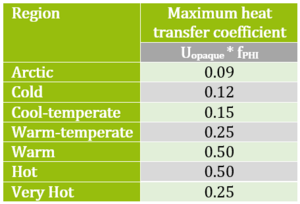Passivhaus: Difference between revisions
(Created page with "A '''passivhaus''' is any building designed to maintain a comfortable indoor air temperature without any active heating or cooling. To stay warm in the winter, a passivhaus relies on sunlight and good insulation. The colder the winter, the more insulation is needed. ===Construction costs=== {{sum|{{rn}} }} Passivehauses are more complex to build, requiring more labor & energy {{qn}} and possibly rarer materials. The increased environmental footprint of...") |
No edit summary |
||
| (One intermediate revision by the same user not shown) | |||
| Line 1: | Line 1: | ||
A '''passivhaus''' is any building designed to maintain a comfortable indoor air temperature | A '''passivhaus''' is any building designed to maintain a comfortable indoor air temperature with little to no active [[heating]] or [[cooling]]. | ||
To stay warm in the winter, a passivhaus relies on sunlight and good insulation. The colder the winter, the more insulation is needed. | To stay warm in the winter, a passivhaus relies on sunlight and good insulation. The colder the winter, the more insulation is needed. | ||
[[File:u value walls table.png|thumb|A passivhaus needs walls that have a low U-value (strong insulation / low thermal conductivity). The limit depends on which region of the world it's in.]] | |||
===Construction costs=== | ===Construction costs=== | ||
{{sum|{{rn}} }} | {{sum|{{rn}} }} | ||
Latest revision as of 22:31, 3 June 2023
A passivhaus is any building designed to maintain a comfortable indoor air temperature with little to no active heating or cooling.
To stay warm in the winter, a passivhaus relies on sunlight and good insulation. The colder the winter, the more insulation is needed.

Construction costs
[RESEARCH needed]
Passivehauses are more complex to build, requiring more labor & energy [QUANTIFICATION needed] and possibly rarer materials.
The increased environmental footprint of construction needs to be weighed against the energy saved on heating & cooling.
Same type of analysis also needs to be done for retrofitting existing buildings to be more passivhaus-like. [Case studies needed]
External links
- Passipedia - a whole wiki dedicated to designing passivhauses